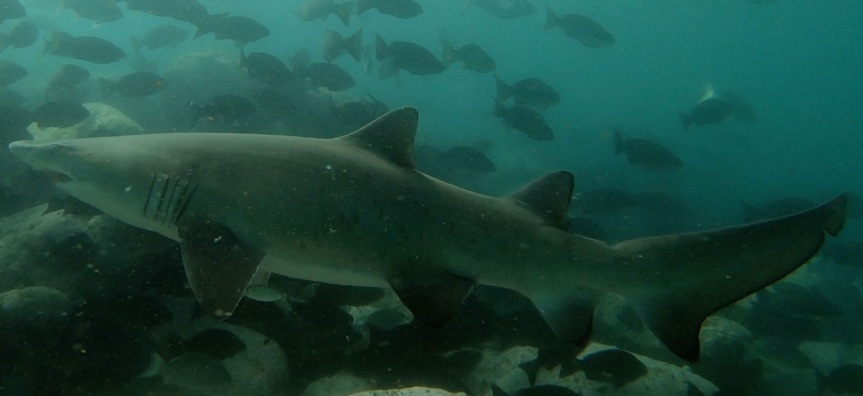
Interview with Sian Liddy, Marine Ecologist. Sian describes why Cabbage Tree Bay is important for Grey Nurse Sharks. The video contains overlay shots of Grey Nurse Sharks and Sian observing their behaviour underwater in the bay.
Video text transcript
(Sian is sitting on the rocks overlooking Cabbage Tree Bay.)
Sian Liddy: The east coast population of Grey Nurse Sharks are listed as critically endangered, so its amazing that we have a chance to see them in Cabbage Tree Bay. They are large wild animals. They can reach up to 3.2 meters. You’ll notice that they are quite slow moving, but its important that they are treated with respect and we don’t actively provoke them as divers.
The Grey Nurse Shark used to be mistaken for a maneater because of their toothy grin, but they are actually gentle giants and not considered to be dangerous to divers at all.
Grey Nurse Sharks are known to eat bony fish, rays, and other smaller species of shark.
Mating occurs in spring for the Grey Nurse Shark. It can be quite impressive displays of mating. The males will overpower the female and actually leave her with evident mating scars along her body. Following that, the most developed embryos will end up eating their siblings. When the sharks are about 10 centimetres in size, they actually have functioning teeth and jaws. As they grow and develop, they also eat the unfertilised eggs. After nine to twelve months, she’ll give birth to two sharks that are about one meter in length – one from each uterus so she has two wombs.
Grey Nurse Sharks are really interesting because they come up to the surface to swallow or gulp air, which they store in their stomach controlling their buoyancy.
Because they are slow to reach maturity, they are really vulnerable to exploitation and damage from overfishing. So, aquatic reserves like Cabbage Tree Bay are vital to ensure these impressive, wild animals the protection they need.
